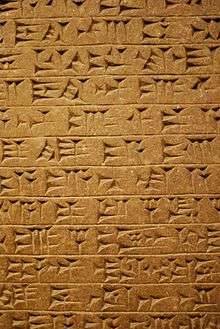cuneiform
English

Assyrian tablet bearing cuneiform script.
Alternative forms
Etymology
From French cunéiforme or New Latin cuneifōrmis, from Classical Latin cuneus (“wedge”) + fōrma.
Adjective
cuneiform (not comparable)
- Having the form of a wedge; wedge-shaped, especially with a tapered end.
- 1936, W. Frank Calderon, Animal Painting and Anatomy, page 297:
- The cuneiform tendon is always sharply defined when the hock is flexed by the action of the muscle.
- 1952, Aileen Fox, Roman Exeter (Isca Dumnoniorum): Excavations in the War-damaged Areas, 1945-1947, page 69:
- The cuneiform leaf is not the characteristic heart-shaped early form (O. and P., p. 241).
-
- Written in the cuneiform writing system.
- 1911, Alvin Sylvester Zerbe, The Antiquity of Hebrew Writing and Literature, page 182:
- There, too, it was originally the vulgar script in contrast with the official cuneiform script employed for all official documents, compacts, etc.
- 2000, Jöran Friberg, A Remarkable Collection of Babylonian Mathematical Texts, page ix:
- The text is inscribed on a clay tablet of a very unusual format. The only other known mathematical cuneiform text on a clay tablet of a similar format is also the only previously known Kassite (and therefore post-Old-Babylonian) mathematical cuneiform text.
-
Synonyms
Translations
having the form of a wedge
|
|
written in the cuneiform writing system
|
|
Noun
cuneiform (plural cuneiforms)
- An ancient Mesopotamian writing system, adapted within several language families, originating as pictograms in Sumer around the 30th century BC, evolving into more abstract and characteristic wedge shapes formed by a blunt reed stylus on clay tablets.
- (anatomy) A wedge-shaped bone, especially a cuneiform bone.
Synonyms
Derived terms
Translations
ancient writing system
|
|
wedge-shaped bone
|
|
See also
This article is issued from
Wiktionary.
The text is licensed under Creative
Commons - Attribution - Sharealike.
Additional terms may apply for the media files.